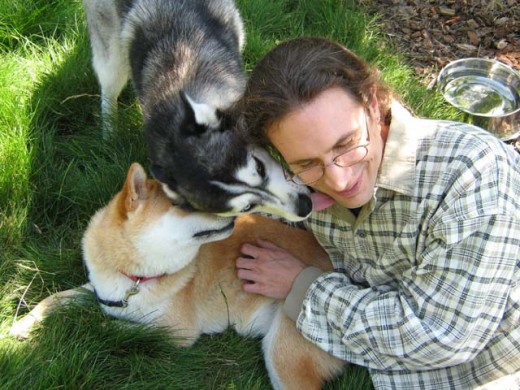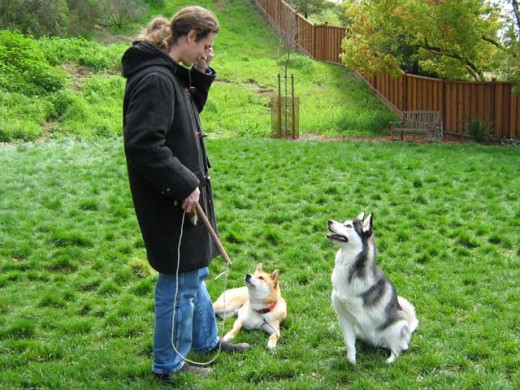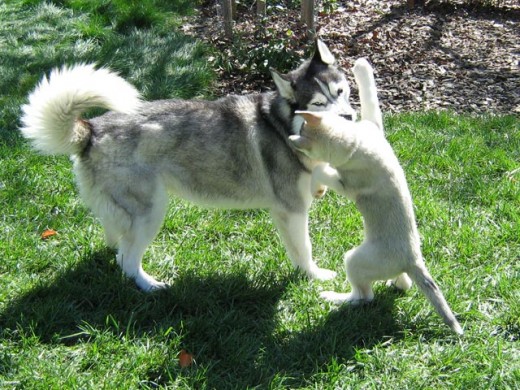Reward dog training allows us to control our dog’s behaviors by controlling his most desired resources, including food, affection, toys, freedom, play, access to people, access to other dogs, and much more.
For reward training to work well, we must first identify what our dog likes. Then,
- We encourage desired behaviors by giving him a reward (positive reinforcement), or
- We discourage undesired behaviors by taking away a reward (negative punishment).
Some common myths about reward dog training –
- Reward dog training does not work with dominant, stubborn, or aggressive dogs.
My Shiba Inu is all of those things and reward methods worked much better on him than aversive dog training. Aversive methods just made him more aggressive. - Using food in dog training is bribery, because the dog should be doing the command for us.
Dogs, like us, are motivated by a variety of things. Some of them are more food motivated, while others are more people motivated. We should use the rewards that are appropriate, based on the temperament and preferences of our dog.
Note that in aversive dog training, the dog is not doing commands just for us either, but rather to avoid the aversive stimulus (e.g. pain). - Reward dog training does not show my dog that I am the boss or pack leader.
The truth is, reward methods allows us to become a better pack leader than aversive methods. In fact, alpha wolves primarily control their members by controlling the pack’s resources – which is basically reward dog training.

Reward Dog Training – Good 1

Reward Dog Training
Helps to build a relationship based on trust.
One of the biggest advantage of reward dog training, is that there is little danger of losing our dog’s trust, even if we make some training mistakes. If we do not do dog obedience training for a living, we may not always execute our techniques perfectly, or even close to perfectly.
Some mistakes will be made, while we learn how to effectively train our dog.
If we are using reward dog training, a mistake may get our dog a bit confused, as to why he is receiving a reward. A string of continuous mistakes, may inadvertently encourage unwanted behaviors, such as jumping, but that is about as bad as it gets.
Aversive dog training, on the other hand, can very easily cause loss of trust. It may even lead to aggression.
In fact this University of Pennsylvania 2009 study shows that at least 25% of the dogs that are trained with confrontational methods, exhibit aggression during training.
“This study highlights the risk of dominance-based training, which has been made popular by TV, books and punishment-based training advocates,”Herron said. “These techniques are fear-eliciting and may lead to owner-directed aggression.”

Reward Dog Training – Good 2
Will not damage our dog either physically or mentally.
With reward dog training, the worst that happens to our dog is the removal of a reward. He may look at us cross-eyed, but he will not go home with a hurt trachea or other bodily harm. In contrast, this type of physical damage can occur, when certain aversive methods are not implemented properly.
Note that prolonged use of choke collars may cause harm to our dog, even when the collar is fitted and used as directed.

Reward Dog Training – Good 3
Helps to create a dog that is happy and eager to work.
When we only use reward dog training, our dog will be eager to work because work time means reward time.
Aversive dog training, on the other hand, may decrease our dog’s interest in working. Our dog may decide to just lie around and sleep, because it is safe, comfortable, and painless, to do so.
Leash training or dog training is not much fun and very stressful, when a dog keeps receiving physical corrections, even when he does not understand what is required of him.

Reward Dog Training – Bad 1
May not always solicit a prompt response to our commands.
For most dogs, a reward may not be as strong a motivator as pain (e.g. leash jerk, slap on the muzzle, finger jabs). In fact, some dogs may dislike an aversive stimulus to such an extent, that they fear it.
Fear is one of the strongest motivators for dogs. Most dogs will respond more consistently, and more promptly to it, compared to a reward.
Consistent and prompt response to commands becomes important, when our dog is involved in a life or death situation, for example when he is running into traffic. However, it should be pointed out that with proper management, we can prevent our dog from being in such dangerous circumstances.
In addition, pain based aversive training is risky, and does not guarantee full behavioral control. In fact, training mistakes and inaccurate timing, may result in even poorer command control, and increased aggression. Therefore, the best way to prevent a dog from running into traffic, is through proper equipment (e.g. doors and leashes), and proper management, similar to how we prevent children from running into traffic. After all, putting a shock collar on a young child, even to prevent the possibility of a traffic accident, would be unconscionable and against the law.

Reward Dog Training – Bad 2
May sometimes require creativity to out-think our dog.
With reward dog training, we may need to get creative and come up with our own obedience training methods. This is especially true when we are trying to stop bad behaviors such as jumping, leash biting, or hand biting.
While there are many reward methods for stopping these behaviors, they may not always work with our dog. I.e. he may decide that the reward from his bad behavior, outweighs our offered reward or negative punishment. As a result, we may need to experiment with a variety of methods and reward systems, before finding one that works well with our dog.
In contrast, fear is a more universal strategy. The same pain based aversive method, for example the leash jerk, can be applied to a wide variety of situations.

Reward Dog Training – Bad 3
May require that we bring along some food or toys when on walks and outings.
Remember though, that dogs do not care about the monetary cost of a reward. Many dogs consider sticks, pine cones, and leaves to be quite exciting and awesome. When I find myself in a situation where I need a quick reward, some are usually readily available in the environment around me.
In fact, it is often very desirable to use the dogs and people we meet during walks, as rewards for our dog. For example, if my dog does not jump, he gets to go up and meet the new person. Once he starts jumping, I move him back, do a sit, and restart the greeting.
As our dog training lessons progress, we can begin to phase out the food rewards. Be careful to phase the rewards out slowly, so that our dog stays motivated.

Reward Dog Training – Bad 4
May cause our dog to gain weight.
Obesity can sometimes become a problem, if we give our dog too many dog treats.
This issue can be easily resolved by –
- Using part of our dog’s regular meals as training rewards,
- Using smaller sized treats, and
- Using a lower calorie food or treat.
All dogs have to eat. It is much more effective to make our dog work for his food, rather than giving it to him for free in a silver bowl.

I started out with aversive dog training but now, I use reward methods almost exclusively. Aversive methods made my Shiba Inu develop even more behavioral issues, including aggression.
In my opinion, it is much better to start with reward dog training because it is safer, builds a stronger bond with our dog, and is easier to implement without harmful side effects. Reward training takes a bit more time, and may not be as visceral as aversive mathods, but it is a more comfortable, fun, and effective way for dogs to learn.
Reward dog training is just better dog kung fu!
Hey there – we’ve got a 7-month old hound mix who is very well mannered/behaved for the most part, a sweetheart for sure. The exception is that she, when on a scent, does not even remotely respond to our repeated calls. We’ve been using reward based training, always walking with small treats in pockets, rewarding her often when its deserved, but the promise of a ‘cookie’ if she ‘comes’ doesn’t cut it when she gets whisked away by a rabbit, bird, deer, or whatever scent. She’ll take off and be gone for sometimes 20 or 30 minutes – just running, smelling, running, smelling. Its concerning!
We’re considering a shock collar but are reluctant for the same reasons you lay out on your site – we don’t want to increase her anxiety, aggression, change her manner, etc.
Any tips on more aggressive training that is not aversive training for a runner?
Thanks.
Hello Adam,
This ASPCA article has a great list of recall techniques and descriptions.
http://www.aspca.org/Pet-care/virtual-pet-behaviorist/dog-articles/teaching-your-dog-to-come-when-called
As you have noted though, some breeds are more difficult to train on recall than others due to strong breed traits. Dogs with high prey drive or those who are bred to follow their nose will do it by instinct, and it will take a very very strong stimulus to trump a natural drive that has been reinforced through many years of selective breeding.
Here is a bit more on my thoughts on this issue-
http://shibashake.com/dog/the-squirrel-instinct-can-it-be-retrained
Both my Sibes have high prey drive, so I walk them on-leash. I have let Shania go off-leash a few times, only in a very safe and quiet area. She came back right away initially, and was really good at checking back with me. However, the next time, she got a bit more confident and went out for longer, and then a big longer. She takes off after squirrels which is not too bad, since they just go up the nearest tree. However, there are deer around the trails as well, and she will definitely take off after them – which would not be good.
Ultimately, I decided that on-leash is best for us, and we have great fun on our hikes. She helps me up hills, I clear brush and stones out for her so that she can dig well, and I also stop her from going into areas with foxtails or chasing after snakes. 😀
I only mentioned a couple of studies in my article. This document from the RSPCA has a good summary of many more scientific experiments that have been conducted on shock collars.
http://www.rspca.org.uk/ImageLocator/LocateAsset?asset=document&assetId=1232713013325&mode=prd
Mishka and I are partial to rewards training over aversive although I have taken to put her choke collar on for neighborhood walks now that the farm animals are out in abundance. We share a carrot with our neighbor horse everyday. Mishka no longer lunges at her.
I acquired Mishka, my 9 month old Sibe because her owners were moving to a hot climate and they didn’t have time to invest in her training. I have had her for 3 months now and we take 3-4 “good” walks a day. I am still having problems with her sneaky peeing when my attention is not focused on her. Sometimes it’s a piddle across the floor and sometimes it’s an ocean of pee when we have walked recently. Do you have any tips for me as I am starting to feel frustrated. I am calm around her because she doesn’t respond to anxious. She sleeps in her cage at night and I latch it to make sure she doesn’t pee willy nilly. I get up early in the morn and we go right away for our first walk.
Hello Mishka,
LOL! I like that – “sneaky peeing”. I was definitely reminded of that when I got a new Sibe puppy last year. 😀
With puppy Lara, supervision was very important during the potty training period. I always had eyes on her when she was roaming in the house and when I am busy, she goes in her enclosure (which has puppy pads), or she goes outside in the fenced backyard.
When she does her business outside, I make sure to mark the behavior (Yes) and reward her really well. She really likes to play, so she gets really good food rewards as well as a fun game. When she tries to go inside, I interrupt her and take her outside.
Here is more on our potty training experiences-
http://shibashake.com/dog/puppy-potty-training-facts-and-myths
Here is a log of my first 10 days with Lara, we had lots of potty mistakes. 😀
http://shibashake.com/dog/a-new-puppy-first-10-days-of-hell
Big hugs to Mishka!
*one red colored
Hello Rusty,
My Shiba Sephy was very fearful of taking a bath. I think it is because the bath is such a confined space, and he also does not really like getting wet especially when standing in a cold tub.
What has worked well for Sephy in terms of bathing is to do it outside and to make it into a game. Now, when Sephy needs a bath I just play the water hose game with him.
http://shibashake.com/dog/dog-play-fun-games-to-play-with-your-dog-or-puppy#waterhose
I take some breaks in the middle to give him a rub down.
Hi, we have two shibas, one black and on red colored. Our red colored one Rusty is a handful. I am wondering how to bathe him. He has become aggressive at bath time.
This is Laurie,I am Teddy’s pack leader.He is two now,but it has been a long road.I had no idea what i was getting into. I was lonely.My dalmation with brown spots I trained with sign language died after 12years with cancer.We looked, slepted on every anamial,but not Teddy.there he was and he picked us. I said here he is
this is him.Wow..but he was ours and i trained TAZ did school shows, i could do this. I did no researsh, I knew he was special and we needed to do things together. But help was needed ,thanks to that show with Ceaser on, I stayed calm as I always did, but with relaxing him into submission worked, no yelling, no hitting, and no shocking. All I am against.In my town the woman who got his brother ducked taped his brother to the frig for all the bitting..she got jail time.I know the bitting was bad, but the relax,calm mathod works.I never had a puppy that bit like he did.All has worked out.I have learned allot and would NEVER trade Teddy for anything.He is loyal,loves uncondionally,protective,sweet to kids, neighbors, family. He is my best friend. My new mate.
Thanks for visiting Jon. Yeah I started out with both as well, but realized as I went along that certain types of aversive methods can be risky and can actually hurt the dog training process.
Now I use reward training almost exclusively, but I think there is little harm in using non-physical based aversive methods such as scent or sound aversive methods.
Hey there. I have a shiba cross and he is a Loveable little guy. We didnt get him until he was 10 months old and came kennel/off leash/”child” trained. His only issue we were directly told about was he was not well socialized. So I started to click train him and all was going well around me until I realized that my roommate was training him completely different and using aversion training. Now my huge issue is that my dog (now 13 month) has become quite aggressive and possessive towards dog and has started to nip at humans. He hasn’t at my wife my child or myself but has at the roommate and other people he has been around many times.
Can I get some advise?
Also we are starting beginner training soon but I worry for other dogs in the class
Does he try to approach other dogs or does he only show aggression when they approach him? When does he nip at people – when the approach him? only inside the house? when he has a toy or food?
While socializing my dogs, what works well is to slowly introduce them to new things in a very positive context. I also make sure to protect them from bad or negative interactions. Here is a bit more on dog socialization.
I do desensitization exercises to help my dogs relax and be comfortable around other dogs. A similar desensitization process can also be used to train a dog to re-associate people with positive experiences.
In terms of classes, what helped most with my Shiba Inu’s dog reactivity issues is to do private sessions with a good trainer that has access to calm dogs. For example, we did desensitization sessions at our local SPCA with one of their trainers several times per week. They would pick dogs that suited Sephy’s personality, and we would do structured exercises with one dog at a time. A group class situation was a bit too much for Sephy, especially when there is not enough space and the other dogs are too close.
I also carefully manage Sephy to ensure that he does *not* engage in any negative greetings or interactions. This can set back training and cause him to become reactive again.
I voted for reward and averse…. both seem to work together.
Great observation Nancy. There is a dog in all of us – some more than others 🙂
Funny, rewards work for dog’s and humans. Is that the “beast” in us coming out??? LOL